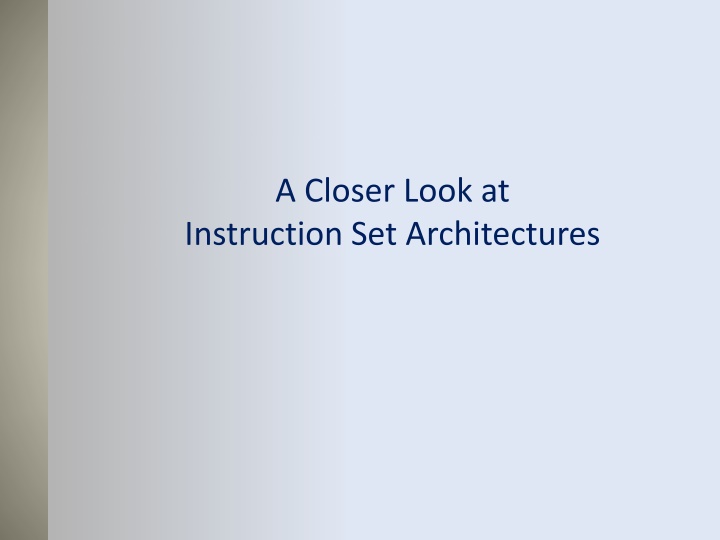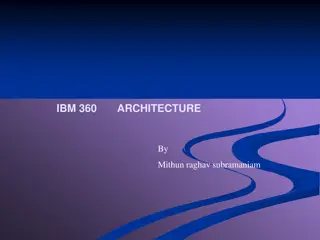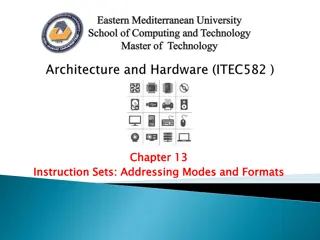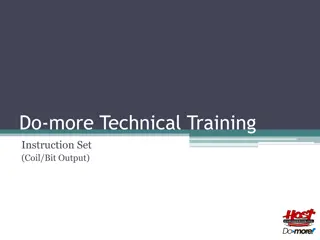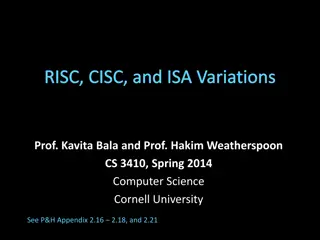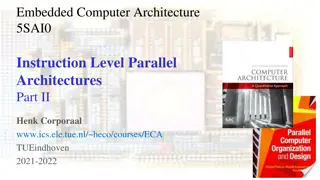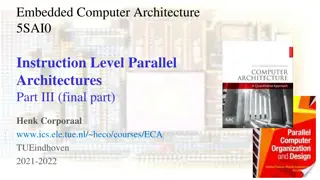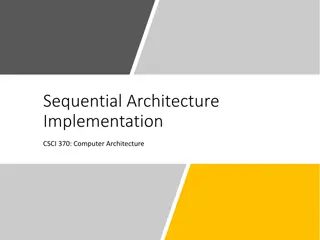A Closer Look at Instruction Set Architectures
This lecture provides an in-depth examination of instruction formats, design decisions for instruction sets, internal storage in the CPU, and the number of operands with their lengths. It delves into the interrelation between machine organization and instruction formats, offering insights into computer architecture.
Download Presentation

Please find below an Image/Link to download the presentation.
The content on the website is provided AS IS for your information and personal use only. It may not be sold, licensed, or shared on other websites without obtaining consent from the author.If you encounter any issues during the download, it is possible that the publisher has removed the file from their server.
You are allowed to download the files provided on this website for personal or commercial use, subject to the condition that they are used lawfully. All files are the property of their respective owners.
The content on the website is provided AS IS for your information and personal use only. It may not be sold, licensed, or shared on other websites without obtaining consent from the author.
E N D
Presentation Transcript
A Closer Look at Instruction Set Architectures
Lecture Overview Introduction Instruction formats Introduction Design Decisions for Instruction Sets Little VS Big Endian Internal Storage in the CPU Number of operands and Instruction Length 2
Introduction Introduction (1/1) We look at different instruction formats, operand types, and memory access methods. We will see the interrelation between machine organization and instruction formats. This leads to a deeper understanding of computer architecture and organization in general. 3
Instruction formats Instruction formats Introduction (1/2) In Chapter (MARIE) we saw that MARIE have an instruction length of 16 bits and could have, at most, 1 operand In another architecture, those could be different So, computer architectures generally differs by their Instructions Set format. An Instruction Set can be described by its features. 4
Instruction formats Instruction formats Introduction (2/2) The Instruction set s features are: Number of bits per instruction: 12, 32 and 64 are the most common Type of the CPU elementary memory: Stack-based or register-based (this will affect the instruction format) Number of operands per instruction: Zero, one, two, and three being the most common. Operand location: register-to-register, register to- memory or memory-to-memory instructions. Types of operations: not only types of operations but also which instructions can access memory and which cannot. Type and size of operands: operands can be addresses, numbers, or even characters. 5
Instruction formats Design Decisions for Instruction Sets (1/4) During the design phase of a computer architecture, the Instruction set must be optimized. The instruction set must match the architecture. It must also maximize the efficiency of the computer architecture. The first thing to define during the design phase is the instruction set format. To understand how this choice is made, we should know first, how we measure the efficiency of an ISA. 6
Instruction formats Design Decisions for Instruction Sets (2/4) Instruction set architectures are measured according to: Main memory space occupied by a program. Instruction complexity: amount of decoding necessary to execute an instruction (number of clock cycles per instruction) Instruction length (in bits). Total number of instructions in the instruction set. 7
Instruction formats Design Decisions for Instruction Sets (3/4) So, things to consider when designing an instruction set include: Instruction length - Short Vs long instructions: shorter instructions take up less space in memory shorter instructions can be fetched quickly shorter instructions limit the number of instructions shorter instructions limit the number of operands - Variable length VS fixed length instructions: Fixed length instructions are easier to decode but Fixed length instructions waste space 8
Instruction formats Design Decisions for Instruction Sets (4/4) Things to consider when designing an instruction set include: Number of operands - Fixed number : Zero, one, two, and three being the most common - Variable number of operands (even if we have a fixed length instructions): Expanding opcode (to be explained in this lecture!) Addressable registers - How many? (number of registers) - How are they stored in the CPU? Memory organization - Word addressable or byte addressable? - A byte addressable architecture uses little or big endian concept? (to be explained in this lecture!) Addressing modes - Direct, indirect, immediate, indexed, etc. (to be explained in this lecture!) 9
Lecture Overview Introduction Instruction formats Introduction Design Decisions for Instruction Sets Little VS Big Endian Internal Storage in the CPU Number of operands and Instruction Length 10
Instruction formats Little VS Big Endian (1/5) If we have a 32 bit data word, how we store this word in a byte addressable memory? The Least significant byte first? Of the most significant byte first? Byte ordering, or endianness, is a major architectural consideration We distinguish two concepts for byte ordering: Little Endian: A byte with a lower significance is stored in a lower address Big Endian: A byte with a higher significance is stored in a lower address 11
Instruction formats Little VS Big Endian (2/5) Example 1: consider an integer requiring 4 bytes: Byte 3 Byte 2 Byte 1 Byte 0 On a little endian machine, this is arranged in memory as follows: Base Address + 0 Byte0 Base Address + 1 Byte1 Base Address + 2 Byte2 Base Address + 3 Byte3 12
Instruction formats Little VS Big Endian (3/5) Example 2: consider an integer requiring 4 bytes: Byte 3 Byte 2 Byte 1 Byte 0 On a big endian machine, this long integer would then be stored as: Base Address + 0 Byte3 Base Address + 1 Byte2 Base Address + 2 Byte1 Base Address + 3 Byte0 13
Instruction formats Little VS Big Endian (4/5) Example 3: On a byte-addressable machine, the 32-bit (8 numbers*4 each hex. Decimal number in binary) hex value 12345678 is stored at address 0. How is this value stored in memory if the machine uses a Big Endian concept? A little Endian concept? Answer: Here in memory the data is stored in HEX. Based, means the following: 1 and 2 for example will 0001 and 0010, here the some of number when calculate 8* 4 (locations)=32 bit 14
Instruction formats Little VS Big Endian (5/5) Advantages of Big Endian: Is more natural: The most significant byte comes first (lower address). The sign of the number can be determined by looking at the byte at address offset 0. Strings and integers are stored in the same order. Advantages of Little Endian: Makes it easier to place values on non-word boundaries. High-precision arithmetic is fast and easy. 15
Lecture Overview Introduction Instruction formats Introduction Design Decisions for Instruction Sets Little VS Big Endian Internal Storage in the CPU Number of operands and Instruction Length 16
Instruction formats Internal Storage in the CPU: Stacks VS Registers (1/5) Another consideration for architecture design concerns how the CPU will store data. We have three choices: A stack architecture. An accumulator architecture. A general purpose register architecture. Designers choosing an ISA must decide which will work best in a particular environment and examine the tradeoffs carefully 17
Instruction formats Internal Storage in the CPU: Stacks VS Registers (2/5) Stack Architecture A stack is used to execute instructions Instructions and operands are implicitly taken from the stack Advantages - Good code density - Simple model for evaluation of expressions Disadvantages - A stack cannot be accessed randomly - Difficult to generate efficient code 18
Instruction formats Internal Storage in the CPU: Stacks VS Registers (3/5) Accumulator architectures One operand of a binary operation is implicitly in the accumulator - Example: MARIE Advantages - Reduce the internal complexity of the machine - Allow very short instructions Disadvantages - Memory traffic is very high (since one operand is in memory) 19
Instruction formats Internal Storage in the CPU: Stacks VS Registers (4/5) General purpose register architectures (GPR) General purpose registers can be used instead of memory Advantages - Registers are faster than memory - Easy for compilers to deal with - Can be used very effectively and efficiently Disadvantages - Long Instructions, long fetch and decode times 20
Instruction formats Internal Storage in the CPU: Stacks VS Registers (5/5) General purpose register architectures (GPR) GPR are the most widely accepted models for machine architectures today There are three types of GPR - Memory-memory architectures: may have two or three operands in memory, allowing an instruction to perform an operation without requiring any operand to be in a register. - Register-memory architectures: require a mix, where at least one operand is in a register and one is in memory. - Load-store architectures: require data to be moved into registers before any operations on that data are performed. 21
Lecture Overview Introduction Instruction formats Introduction Design Decisions for Instruction Sets Little VS Big Endian Internal Storage in the CPU Number of operands and Instruction Length 22
Instruction formats Number of operands and Instruction Length (1/6) On current architectures, instructions can be formatted in two ways: Fixed length: Wastes space but is relatively fast. Variable length: Complex to decode but saves storage space. In this course, we will be interested in Fixed length instructions. In such instructions, we define the maximum number of operands (this number has a direct impact on the length of the instruction itself) 23
Instruction formats Number of operands and Instruction Length (2/6) Example: MARIE uses a fixed-length instruction with a 4-bit opcode and 12-bit operand. In MARIE the maximum number of operands is one. Though, some instructions for MARIE have no operand (for instance: halt). 24
Instruction formats Number of operands and Instruction Length (3/6) The most common instruction formats include zero, one, two, or three operands: Zero operand - OPCODE only One operand (usually a memory address) - OPCODE + 1 Address Two operands (usually registers, or one register and one memory address) - OPCODE + 2 Addresses Three operands (usually registers, or combinations of registers and memory) - OPCODE + 3 Addresses 25
Instruction formats Number of operands and Instruction Length (4/6) Machine instructions that have no operands must use a stack In architectures based on stacks, most instructions consist of opcodes only; however, there are special instructions that have just one operand: Push X places the data value found at memory location X onto the stack Pop X removes the top element in the stack and stores it at location X 26
Instruction formats Number of operands and Instruction Length (5/6) Example: Suppose we wish to evaluate the following expression: Z = (X x Y) + (W x U) The assembly code would be: For a Three operand ISA For a Two operand ISA For a one operand ISA (such as MARIE!) Mult R1, X, Y Mult R2, W, U Add Z, R2, R1 Load R1, X Mult R1, Y Load R2, W Mult R2, U Add R1, R2 Store Z, R1 Load X Mult Y Store Temp Load W Mult U Add Temp Store Z 27
Instruction formats Number of operands and Instruction Length (6/6) Example: Suppose we wish to evaluate the following expression: Z = (X x Y) + (W x U) In a stack architecture the assembly code would be : Stack Stack Push Y Y X X For a zero operand ISA Mult Push X Push Y Mult Push W Push U Mult Add Store Z Stack X x Y Stack Push W; Push U X x Y + W x U Stack Add U Stack Mult W x U W X x Y W x U 28
